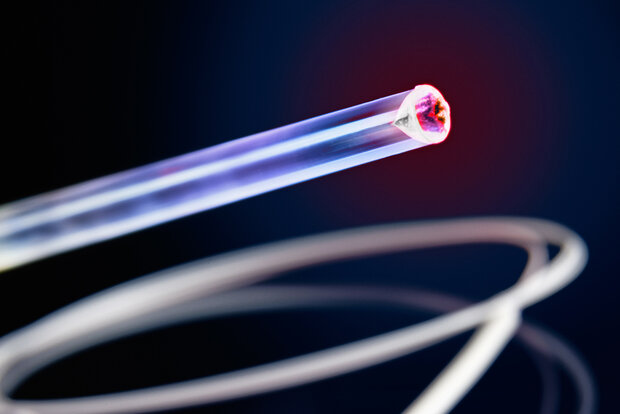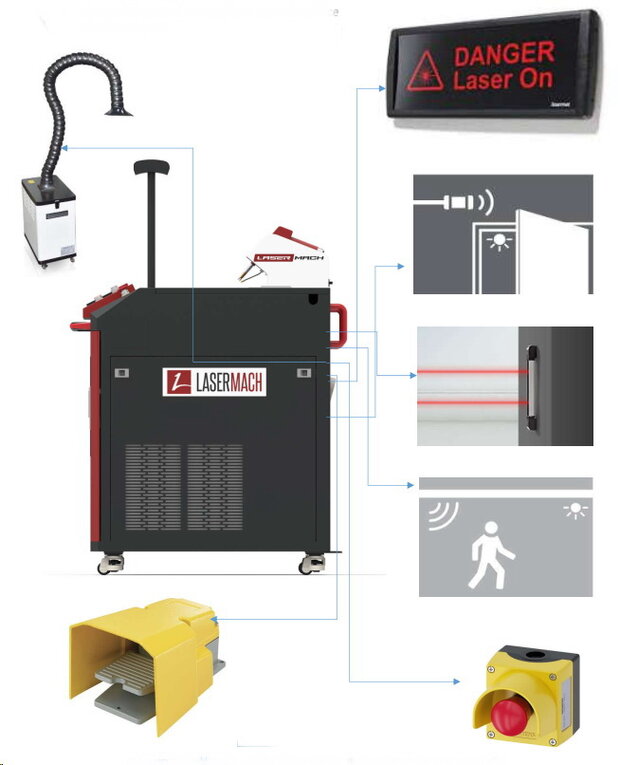INTERNATIONAL SAFETY STANDARDS
Government regulations define required safety measures for people who may be exposed to lasers.
- For the US, the American National Standards Institute Standard ANSI Z136.1: American Standard for Safe Use of Lasers and ANSI Z136.9: American National Standard for Safe Use of Lasers in Manufacturing Environment is applied.
- In Canada and the European Community, eye protection requirements are specified in the European standard EN 207 and IEC 60825-1.
Laser systems are categorized according to their ability to produce damage to exposed eye and skin. From class 1 (no hazard during normal use) to class 4 (severe hazard for eyes and skin). One thing to keep in mind is that all industrial lasers for material processing are classified as Class 4. However, using suitable enclosures and methods allows to turn them into Class 1 laser system.

Laser welding standards to know
No less than 9 standards apply to the welding trades, for safety issues and to guarantee the quality of the results thanks to a control system. The main laser standards to be aware of are:
-
NF EN ISO 13919, which sets a frame of reference for laser welding: it makes it possible to assess the level of requirement and the acceptable defects on leaving the workshop;
-
NF EN ISO 15614-11 and NF EN ISO 15609-04, relating to the qualification of operating modes and their descriptions;
-
NF EN ISO 14732, concerning the qualification of welding professionals for mechanized welding (operators, adjusters, etc.).
Other standards exist and apply in specific sectors such as aeronautics or aerospace – such as the ISO 24394 standard on the qualification of welders.
ALL THE LASER WELDING STANDARDS AND NORMS YOU NEED TO KNOW!
European laser Welding Standards
Laser welding is no exception to the standards. On the contrary: they are essential and form a framework that allows you to work in the best conditions. These norms and standards are our reference tools on which we rely to protect ourselves and guarantee a result. Let's take a look on all the standards of laser welding to know.
EN ISO 3834 company certification
The EN ISO 3834 company certification describes the quality requirements for fusion welding of metallic materials: it thus integrates quality into the welding process itself, at the time of manufacture.
It is used in many product standards, in particular for pressure equipment, boilers and piping as well as for the transport of hazardous materials.
EN 4678 and L06-395 – Frameworks for the aeronautical sector
While the EN 4678 standard dates from 2012 and the L06-395 standard dates back to 2000, both govern the aerospace industry and are equivalent, except for a few details. They define the rules to be respected to guarantee the quality of aerospace constructions in metallic materials welded and brazed by laser beams. Their application covers the manufacture of new parts but also repairs, under the responsibility of a supplier or an approved company.
Small particularity for the EN 4678 standard: the designer defines 3 levels of criticality of the assembly (B, C and D) according to the consequences of a rupture of this assembly on the fall of the device. These are correlated with the fault analysis levels of the ISO 13919 standard. Thus, if the breakage of the assembly causes the device to fall, it is classified as "severe requirement", level B.
EN ISO 13919 – The reference framework for laser welding
Updated in December 2018, the ISO 13919-1 standard establishes an international level standard and makes it possible to assess the levels of defects present in steel, nickel, titanium or aluminum assemblies welded by electron beam or laser beam. The ISO 13919-2 standard deals with aluminum and aluminum alloys.
Its three levels of quality requirements on leaving the workshop (B: high, C: medium and D: moderate), make it applicable to a wide range of achievements, whether welding with or without wire. filler, alloyed or unalloyed steels, or even materials welded by electron beam or laser.
EN ISO 14732 – Qualification of welding operators
The ISO 14732 standard concerns the qualification of personnel, welding operators and setters in mechanized or automatic welding of metallic materials. It defines the requirements relating to the qualification of these operators, and applies when this is required by the contract or the application standard. This latter standard replaced standard EN 1418, which disappeared in 2013.
EN ISO 15609-04 – Description of operating modes
The ISO 15609-04 standard specifies the requirements relating to the description of the welding procedure (WPS) by laser beam. This document allows the welder to formally record the parameters that have an influence on the metallurgical and mechanical quality, the geometry of the structure and the solidity of the assembly.
The standard applies to all laser beam welding procedures, including hardfacing welding.
EN ISO 15614-11 – Qualification of operating methods
Standard 15614-11 describes and qualifies a welding procedure for metallic materials, defines the conditions for performing qualification tests and the limit of validity of a procedure.
It applies to all metallic materials, whether for repair work or the production of new parts, regardless of their shape, thickness and heat treatment!
ISO 24394 – Qualification of personnel in the aerospace sector
More specific than the previous one, the ISO 24394 standard also concerns personnel, but it determines the requirements relating to the qualification of welders when the components are intended for aerospace applications.
ECSS-Q-ST-70-39C – Aerospace industry standards
ECSS-Q-ST-70-39C is the European standard applicable to welding in the aerospace industry. It specifies processing and quality requirements for flight and ground equipment.
The RCC-M code - Nuclear and Reactors Standards
Although it is not a standard in the proper sense, the RCC-M code defines the rules for the design and construction of mechanical equipment for nuclear islands of pressurized water reactors. Laser welding, however, is only processed quickly in the RCC-MRx.
These laser welding standards come together and constitute real resources in the quest for quality. They are there to be used, even to inspire when they prove to be insufficient, as may be the case when it is.
Photonweld Machines and CE regulations on laser welding - Photonweld Machines and Laser Safety

Lasermach PhotonWeld Series
The Safest handheld laser welding machine on the market
Respecting on all following CE regulations:
- EC 2006/42/EC – EC Directive Machinery
- EC 2006/35/EU – Low voltage directive
- ISO 12100 P1,P2 – Basic Standards Safety of Machinery
- ISO 13857 Generic Standards Safety on hazard zones around Machinery
- ISO 13849-1 Generic Standards Safety related Parts of Control System
- ISO 13850 Generic standards Safety design of emergency stops
- ISO 14119 Generic standards interlocking devices associated with guards
- ISO 11145 laser equipment Vocabulary and symbols
- ISO 11553-1 Safety standards of laser processing devices
- ISO 11553-2 Safety standards of handheld laser processing devices
- EN 60204-1
- EN 60825-1
ISO 3821 - EN 559:2003: Gas welding equipment - Rubber hoses for laser welding gasses
RUBBER HOSE FOR WELDING: Minimal Three layer hoses, made of SBR, with textile fibre reinforcement.
Those hoses comply with ISO 3821 standard. They are very flexible (even at low temperature) and have a very good resistance to abrasion prolonging hose life. They can be used in any climatic conditions. This standard specifies requirements for rubber hoses for normal duty up to 2 MPa (20 bar) and light duty [limited to hoses for maximum operating pressure up to 1 MPa (10 bar) and with nominal bore less than or equal to 6,3 mm].
This standard pertains to hoses operated at temperatures - 20 °C to + 60 °C.
Standard welding hose fittings with Worm drive or ‘O’ type ring clamps. Crimping is possible with non damaging connectors.
Thermoplastic hoses specified in EN 1327 are excluded from this standard.
Gas fittings for Laser Welding Machines – general information
Fittings for high pressure gas hoses used at laser welding machines have specific types of connection adjusted to match the valves of gas cylinders, made according to EN ISO 10297, DIN 477 and other standards. The standards precisely define numerous types of connections, their dimensions, threads and assign them to particular gases. For flammable gases, left-hand thread fittings are basically used. The fittings must be made of materials resistant to the corrosive effect of the gas.
Specialty gases cylinder outlets : The standards referred to are occasionally implemented with slight variations in the countries where the standard applies, eg DIN in Europe. Right handed, external thread is the normal tread unless LH (left handed) on INT (Internal) is annotated. If required, the actual cylinder outlet should be confirmed with your local supplier at the time of supply.
- NF AFNOR (Association Française de Normalisation) NF C
- BS 341 (British Standard) BS 341 No. 3
- CGA (US Compressed Gas Association) CGA 170
- DIN 477 (Deutsche Industrie Norm) DIN 477 No. 6
- ISO 5145 (Provisional standard, previously NEVOC) ISO 5145 No.30
- ITC EP-6 (Instrucción Técnica Complemetaria - Equipos Presión) - TIPO C
- NEN 3268 (Nederlandse Norm) - RU 3
- UNI (Ente Nazionale Italiano di Unificazione) - UNI 4412

Photonweld-Series: Full CE Safety certified Handheld Laser Welding Machines
Optional Equiped with a lot of supplementary Safety accesoiries connections in plus beside the standard CE Connections
- Laser beam Emission indicator + external emission warning indicator control
- Remote interlock connector with Multi safety interlocks:
- Nozzle contact interlock
- Door contact (external) interlock
- Foot pedal (dead’s men pedal) interlock (opt.),
- Hardware Key control lock
- Internal and external double wired emergency stop (opt.)
- Failsafe start-stop control
- Active Control of start and stop from external fume extraction system
WE HOLD SAFETY OF PEOPLE IN HIGH ESTEEM!

Laser welding standards to know
Laser welding professions do not escape standards, these reference tools on which we rely to protect ourselves and guarantee a result. On the contrary: they are essential and form a framework that allows you to work in the best conditions.
Let's take stock of the laser welding standards you need to know.
NF EN ISO 13919 – The reference framework for laser welding
Updated in December 2018, the ISO 13919-1 standard establishes an international level standard and makes it possible to evaluate the levels of defects present in steel, nickel, titanium or aluminum assemblies welded by electron beam or laser beam . The ISO 13919-2 standard deals with aluminum and aluminum alloys.
Its three levels of quality requirements when leaving the workshop (B: high, C: medium and D: moderate), make it applicable to a wide range of projects, whether wire or wireless welding. filler, alloyed or unalloyed steels, or even materials welded by electron beam or laser.
| EN ISO 3834 company certification EN ISO 3834 company certification describes the quality requirements for fusion welding of metallic materials : it thus integrates quality into the welding process itself, at the time of manufacturing. It is used in many product standards, in particular for pressure equipment, boilers and pipes as well as for the transport of dangerous materials. |
NF EN 4678 and NF L06-395 – Frameworks for the aeronautics sector
While the NF EN 4678 standard dates from 2012 and the NF L06-395 standard dates back to 2000, both govern the aerospace industry and are equivalent, apart from a few details.
They define the rules to be respected to guarantee the quality of aerospace constructions in metallic materials welded and brazed by laser beams . Their application covers the manufacture of new parts but also repairs, under the responsibility of a supplier or an approved company.
Small particularity for the EN 4678 standard: the designer defines 3 levels of criticality of the assembly (B, C and D) depending on the consequences of a breakage of this assembly on the fall of the device. These are correlated to the fault analysis levels of the ISO 13919 standard. Thus, if the breakage of the assembly causes the device to fall, it is classified as “severe requirement”, level B.
| The ECSS-Q-ST-70-39C standard The ECSS-Q-ST-70-39C standard is the European standard applicable to welding in the aerospace industry . It specifies processing and quality requirements for flight hardware and ground equipment. |
NF EN ISO 15614-11 – Qualification of operating methods
Standard 15614-11 describes and qualifies a welding procedure for metallic materials , defines the conditions for carrying out qualification tests and the limit of validity of a procedure.
It applies to all metallic materials, whether for repair work or the production of new parts, regardless of their shape, thickness and heat treatment!
NF EN ISO 15609-04 – Description of operating modes
The ISO 15609-04 standard specifies the requirements relating to the description of the laser beam welding procedure (DMOS). This document allows the welder to formally record the parameters which have an influence on the metallurgical and mechanical quality, the geometry of the structure and the solidity of the assembly.
The standard applies to all laser beam welding procedures, including cladding welding.
NF EN ISO 14732 – Qualification of welding operators
The ISO 14732 standard concerns the qualification of personnel , welding operators and adjusters in mechanized or automatic welding of metallic materials. It defines the requirements relating to the qualification of these operators, and applies when this is required by the contract or the application standard. This latest standard replaced the NF EN 1418 standard, which disappeared in 2013.
ISO 24394 – Qualification of personnel in the aerospace sector
More specific than the previous one, the ISO 24394 standard also concerns personnel, but it determines the requirements relating to the qualification of welders when the components are intended for aerospace applications .
| The RCC-M code Although it is not a standard in the literal sense, the RCC-M code defines the rules for the design and construction of mechanical equipment for nuclear islands in pressurized water reactors. Laser welding, however, is only processed quickly in the RCC-MRx. |
These laser welding standards come together and constitute real resources in the quest for quality. They are there to be used, or even to inspire when they prove insufficient, as can be the case when it comes to welding applied to the medical sector .

